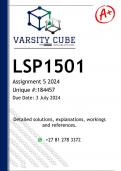LSP1501
Assignment 5 2024
Unique #:184457
Due Date: 3 July 2024
Detailed solutions, explanations, workings
and references.
+27 81 278 3372
, QUESTION 1
1.1. True
1.2. False
1.3. True
1.4. False
QUESTION 2
2.1 Installation Art
2.2 Pottery
2.3 Collage
2.4 Drawing
2.5 Printmaking
QUESTION 3
3.1.
Encouraging social development in a Grade 1 classroom can be effectively
achieved through integrating art activities that foster a sense of emotional
satisfaction and cooperative engagement among students. One approach is to
design collaborative art projects where children work together in small groups to
create a mural or a large-scale collage from recycled materials. This setup requires
them to share materials, communicate their ideas, and agree on the design,
thereby learning valuable skills in cooperation and give-and-take.
Additionally, incorporating activities such as dance and creative movement can
further enhance social development. For instance, organizing regular dance
sessions where children can express themselves through movement allows them
to experience nonverbal communication and understand social rules like turn-
taking and spatial awareness. These activities not only promote gross motor skills
but also teach children to consider others within a shared space, thus fostering
sensitivity and empathy.
Varsity Cube 2024 +27 81 278 3372
, By ensuring that every child participates equally and is not singled out, you promote
an inclusive environment where confidence and emotional control can thrive. This
setup encourages even the shyest learners to engage, build self-esteem, and
experience the joy of communal creativity, ultimately fostering a socially
harmonious and supportive classroom atmosphere.
OR
In a Grade 1 classroom, encouraging social development can be effectively
achieved through integrating various art activities. For example, providing children
with opportunities to engage in collaborative art projects such as mural painting or
group collage-making allows them to practice sharing resources and ideas. By
working together toward a common goal, students learn the importance of
cooperation and collective effort. Equally significant is assigning them roles in
cleanup and organization, fostering a sense of responsibility and accountability.
To further enhance social interaction, incorporating activities like group singing,
dancing, and theatre can be especially beneficial. These forms of creative
expression teach children to pay attention to each other, understand social cues,
and respect the dynamics of give-and-take. Dance, in particular, acts as a
nonverbal form of communication, helping children to internalize social values and
practice emotional control.
By rotating leadership roles in these activities, each child gets a chance to lead
without fear of judgment, building confidence and mutual respect. Through these
methods, children not only find emotional satisfaction and independence in their
artistic choices but also cultivate essential social skills that are foundational for their
overall development.
3.2.
Vygotsky’s theory of social development, particularly the concepts of the Zone of
Proximal Development (ZPD) and scaffolding, offers a valuable framework for
understanding and assisting a child in creating scribbles. According to Vygotsky,
Varsity Cube 2024 +27 81 278 3372




